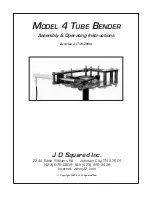
MOUNTING PROCEDURES:
Use this mounting procedure to position the field wires in the backbox so that they use minimum space and produce minimum stress on the product. This
is especially important for stiff, heavy gauge wires and wires with thick insulation or sheathing.
1.
Connect field wires to the MT terminal block (polarity must be observed).
2.
Bend the field wires up 90
°
at the connection to the terminal block.
3.
Carefully push the field wires into the backbox by hand.
4.
Carefully press the MT to the backbox, verifying that the MT is seated and aligned correctly.
5.
Screw the MT to the backbox using the screws supplied. Refer to Mounting Options for screw size.
6.
The effect of shipping and storage temperatures do not adversely affect the performance of the appliances when stored in the original cartons and
are not subjected to misuse.
7.
The knock-out opening on the backbox is sized for ½” conduit and matching connector. Be sure that a proper watertight conduit fitting is used to
connect the backbox for outdoor/severe environment applications.
MOUNTING NOTES:
WARNING: WHEN USING AN OUTDOOR BACKBOX, THE BACKBOX MUST BE WALL MOUNTED ON A FLAT SURFACE, SO
THAT THE WALL COVERS THE ENTIRE BACK SURFACE, AND WITH THE DRAIN HOLES POINTED DOWN TOWARD THE
GROUND AND “TOP” FACING UP. FOR AN OUTDOOR APPLICATION OR A NEMA 3R APPLICATION THE KNOCKOUTS IN THE
REAR OF THE BACKBOX MUST REMAIN INTACT.
CAUTION:
Check that the installed product will have sufficient clearance and wiring room prior to installing backboxes and conduit, especially if
sheathed multiconductor cable or 3/4" conduit fittings are used.
1.
Conduit entrances to the backbox should be selected to provide sufficient wiring clearance for the installed product.
2.
When terminating field wires, do not use more lead length than required. Excess lead length could result in insufficient wiring space for the
signaling appliance.
3.
Do not pass additional wires (used for other than the signaling appliance) through the backbox. Such additional wires could result in insufficient
wiring space for the signaling appliance.
CAUTION:
If Multitone Strobe appliances are operated within 15 inches of a person's ear, they can produce a sound pressure level that exceeds the
maximum 120 dBA permitted by ADA and OSHA rules. Exposure to such sound levels can result in damage to a person's hearing.
WARNING: WHEN INSTALLING STROBES IN AN OPEN OFFICE OR OTHER AREAS CONTAINING PARTITIONS OR OTHER
VIEWING OBSTRUCTIONS, SPECIAL ATTENTION SHOULD BE GIVEN TO THE LOCATION OF THE STROBES SO THAT THEIR
OPERATING EFFECT CAN BE SEEN BY ALL INTENDED VIEWERS, WITH THE INTENSITY, NUMBER, AND TYPE OF STROBES
BEING SUFFICIENT TO MAKE SURE THAT THE INTENDED VIEWER IS ALERTED BY PROPER ILLUMINATION. FAILURE TO
DO SO COULD RESULT IN PROPERTY DAMAGE AND SERIOUS INJURY OR DEATH TO YOU AND/OR OTHERS.
WARNING: A SMALL POSSIBILITY EXISTS THAT THE USE OF MULTIPLE STROBES WITHIN A PERSON'S FIELD OF VIEW,
UNDER CERTAIN CIRCUMSTANCES, MIGHT INDUCE A PHOTO-SENSITIVE RESPONSE IN PERSONS WITH EPILEPSY. STROBE
REFLECTIONS IN A GLASS OR MIRRORED SURFACE MIGHT ALSO INDUCE SUCH A RESPONSE. TO MINIMIZE THIS POSSIBLE
HAZARD, COOPER WHEELOCK STRONGLY RECOMMENDS THAT THE STROBES INSTALLED SHOULD NOT PRESENT A
COMPOSITE FLASH RATE IN THE FIELD OF VIEW WHICH EXCEEDS FIVE (5) Hz AT THE OPERATING VOLTAGE OF THE
STROBES (SEE TABLE 6). COOPER WHEELOCK ALSO STRONGLY RECOMMENDS THAT THE INTENSITY AND COMPOSITE
FLASH RATE OF INSTALLED STROBES COMPLY WITH LEVELS ESTABLISHED BY APPLICABLE LAWS, STANDARDS,
REGULATIONS, CODES AND GUIDELINES.
NOTE:
NFPA 72/ANSI 117.1 conform to ADAAG Equivalent Facilitation Guidelines in using fewer, higher intensity strobes within the same protected
area.
These appliances can produce a distinctive three pulse Temporal Pattern Fire Alarm Evacuation Signal for total evacuation in accordance with NFPA 72.
CAUTION:
Check the installation instructions of the manufacturers of other equipment used in the system for any guidelines or restrictions on
wiring and/or locating Notification Appliance Circuits (NAC) and notification appliances. Some system communication circuits and/or audio circuits, for
example, may require special precautions to assure immunity from electrical noise (e.g. audio crosstalk).
The Multitone Strobe products and these instructions are copyrighted by Cooper Wheelock and the Multitone Strobe products contain proprietary,
confidential and trade secrets of Cooper Wheelock. No part of the Multitone Strobe products and these instructions may be photocopied, printed or
reproduced in any form or modified, adapted, changed or enhanced, or converted to another programming language, or used to create updated, related or
derivative works, without the prior written consent of Cooper Wheelock. No part of the Multitone Strobe products shall be decompiled, disassembled or
reverse engineered.
ANY MATERIAL EXTRAPOLATED FROM THIS DOCUMENT OR
FROM
COOPER WHEELOCK MANUALS OR OTHER
DOCUMENTS DESCRIBING THE PRODUCT FOR USE IN PROMOTIONAL OR ADVERTISING CLAIMS, OR FOR ANY OTHER USE,
INCLUDING DESCRIPTION OF THE PRODUCT'S APPLICATION, OPERATION, INSTALLATION AND TESTING IS USED AT THE
SOLE RISK OF THE USER AND COOPER WHEELOCK WILL NOT HAVE ANY LIABILITY FOR SUCH USE.
NOTE:
This equipment has been tested and found to comply with the limits for a Class B digital device, pursuant to Part 15 of the FCC Rules. These
limits are designed to provide reasonable protection against harmful interference in residential installation. This equipment generates, uses and can
P84601 J
Sheet 5 of 6
























